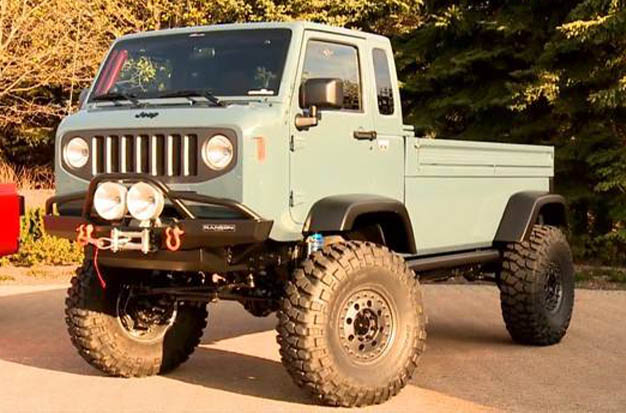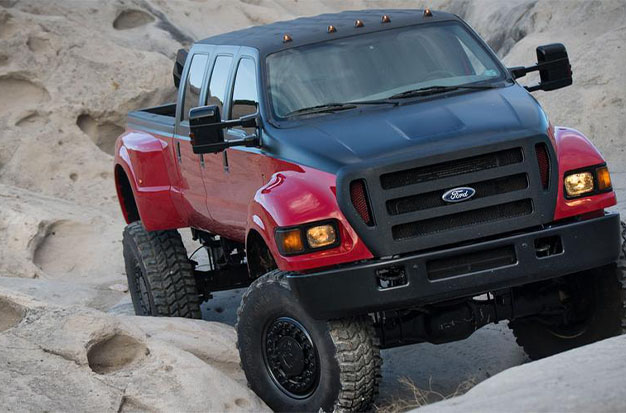A pickup truck is considered to be squatted if the front end has a lift kit installed, but the rear end’s ride height is left at stock, or even lower. Squat trucks have become more and more common over the past five years. However, there is some disagreement over the origin of squatted trucks, which go by a variety of names. Please continue reading for more information.
Squatted Trucks: What Are They?
A truck that has been modified so that the front is lifted higher than the rear causes the rear to appear squat. Your truck’s bed is low and the truck’s nose is raised.
California started this trend, which then spread to the rest of the nation. Members of the Baja Racing Circuit modified their trucks to improve their performance in the sand- and hill-covered desert races. The truck was designed to be squat so that the rear would hit the ground first when the racer descended from a jump at high speed, preventing a collision.
The racers were able to execute dangerous jumps while maintaining control of the truck and preventing a nosedive. The majority of the riders had their sun visors on their caps facing backward. Today, hats are still worn backward while driving, even by those with squat trucks.
This is due to the fact that when a truck is squatted, the nose is raised so high that the brim of the hat blocks the driver’s view of anything past the truck’s dash.
Since the desert races are no longer held, squatting is no longer necessary. Beyond the desert racetracks, there was no benefit to lifting the front more than the rear.
Most people who squat their trucks do so to alter the appearance of their vehicles. The truck does not need to be squatted unless you frequently drive off the road. Except in extreme cases where it is essential to your truck’s operation, I do not advise squatting.
What Other Names Do Trucks That Are Squatted Go By?
Fans of squatted trucks refer to the action by a variety of names. It’s sometimes referred to as the “Carolina Squat.” The terms “California Lean” and “Cali Lean” are sometimes used to describe a truck or SUV.” The Tennessee Tilt is another name for a squat.”
Many recently manufactured trucks are built in a “raked” position. It follows that the bed is marginally higher than the cab. This is so that trucks will balance out because truck engineers design trucks to carry weight in the bed.
A “leveling kit” is frequently purchased by truck owners.” This kit raises a truck’s front end a short distance in order to level it out. Certain trucks can also be leveled by lowering the bed a few inches and removing the lift blocks from the rear springs.
The majority of people who are fans of squatted trucks will understand what you mean if you say “squatted truck” or “truck with a reverse rake” position. They may, however, refer to their squatted trucks in a different way depending on where in the nation you are. See more about What Is a Reefer Truck?
Why Is The Carolina Squat Popular?
There are trucks with sagged rears everywhere. It begs the question: Are squatted trucks against the law?
Even though they present a risk, they are indeed legal. A lot of people posted pictures of their squatted trucks on social media, which helped these trucks gain popularity. The majority of people discovered the trend on Instagram, where squatted trucks first gained popularity before spreading to other platforms.
On Instagram, you will find a number of pages devoted to these trucks if you search for terms like “truck lean,” “truck squat,” “Carolina lean,” or “squatted trucks.” The majority of the pages’ thousands of followers are from Georgia, Louisiana, North and South Carolina, as well as California.
These are the states where squatted trucks are most prevalent. Despite the fact that social media made the trend popular, producers have also adopted it and are creating squat kits that allow the modification.
On front-suspension trucks, squatting is common.

The Price Of Squatting A Truck
To squat your truck, you’ll spend anywhere from a few hundred dollars to $10,000. Depending on the size of your truck, the squat kit you select, and whether you do it yourself or hire a pro, the cost of squatting the truck will vary. Again, it depends on how much lifting you need to do with the truck.
You will only have to pay a few hundred dollars for simple body lifts of two inches or less. You won’t spend more than $50 on a DIY lift kit, but this kit will only include a few straightforward parts. You’ll need to spend between $500 and $5,000 to get a high-quality kit.
Depending on the parts they must fit and the complexity of the work, mechanics will charge you between $200 and $1,500. If you know how to lift your truck, you can perform the task at home and avoid paying a mechanic’s visit fees.
Do Trucks With Squats Pose A Risk?
This modification is hazardous because it tilts the front of the truck or car upward, making it difficult for drivers to see clearly in front of them as they drive. Traffic collisions could result from this. Additionally, the truck’s front height affects how well the driver can see in front of them. As a result, there is a higher chance of a crash.
Furthermore, the truck’s tilt makes it impossible for the headlight to illuminate the road as effectively as the car’s manufacturer intended. As a result, it might blind other approaching cars, potentially causing an accident.
Due to the truck’s upward tilt and the vehicle’s rear being lowered, the suspension of the vehicle ages more quickly. The braking system is negatively impacted by this modification as well. Consequently, there is a chance that traffic accidents could be caused by these modifications to the vehicle.
Squatting your truck also affects its ability to haul or tow. See more about What Is A Straight Truck?
Is It Bad To Squat In Your Truck?
If you intend to drive your truck off the road at very high speeds, squatting it is not a bad idea. You’ll have to jump over the hills and rocks, and a truck that is squatted lands better than other trucks. Squatting is a bad idea due to the decreased likelihood that you will be off-road racing or driving very fast while there.
Your truck’s performance and geometry are changed when you squat it. There will be problems if you only use your truck for on-road travel. In the U.S., squatting is legal.S., but perhaps within the ensuing few years.
The modification is deemed unsafe by a large number of people, who have banded together to demand that it be made illegal. Several petitions highlighting the risks posed by squatted trucks have been submitted, and they may soon produce results.
For example, the practice is decried as offensive in California. On social media, those opposed to it are very vocal and believe it to be dangerous for the general public. These people ask people to be aware of the dangers of a squatted truck and to stay away from it.
Should You Squat Your Truck?
There are trucks that adapt to the changes well and others whose performance and appearance are completely destroyed. A truck won’t perform as the automaker intended when the geometry is changed and factory specifications are violated. It is best to avoid squatting your truck unless it is absolutely necessary.
An absolute necessity, in this case, means that you will be racing through hilly deserts, and you must prevent a nosedive. If that isn’t the case, a squat is useless and you should stay away from it.
You can change a truck’s driving and towing characteristics by squatting down on it. To ensure the speedometer and odometer read correctly after the squat, you must make additional adjustments, such as on the computer. Again, if you have never lifted a truck before, avoid doing so yourself as you might damage some parts of your truck in the process.
Do You Know How To Squat A Truck?
With your truck or SUV, it’s not difficult to acquire a little of that “Cali Lean,” “Carolina Squat,” or “Tennessee Tilt”: order a moderate lift kit and only install the front components. However, a more dramatic squat requires more engineering.
You won’t save much money by only ordering the front half of a lift kit because the majority of the re-engineering necessary to lift a truck takes place at the front of the truck. Therefore, extremely squat trucks need a costly nine or even ten-inch lift. In order to create a more angular design, some builders also remove the leveling blocks from the rear suspension.
A truck’s handling changes when it is squatted. The truck will corner even worse than a typical lifted truck. Additionally, it will be able to support less weight in the bed before bottoming out. Lastly, a truck’s hood is raised while the driver is reclined while squatting: it dramatically increases forward visibility.
Trucks that are squatted pose a serious threat to pedestrians because of their limited forward visibility. Installing an aftermarket “parking” or “trail” camera up front might be a good idea if you want to squat your truck so low. It aids low-speed visibility and functions much like your stock backup camera.
Conclusion
The trucks appear fantastic to the younger generation and are perfect for gaining Instagram followers, but what good are followers doing if driving a truck is dangerous? Your safety and the safety of other road users should be your top priorities as a driver, which necessitates avoiding squat trucks.
You can opt for air rides or suspension stabilizers if you still want the squatted truck’s appearance and performance. These are more expensive options, but they are safer than squatting and have adjustability.
A truck is designed to tow and haul loads, so if a modification prevents either of those from happening, it is the incorrect modification. Any modifications you make to your truck should enable off-roading rather than prevent it. Your truck becomes less of a workhorse and less of an off-roader when you squat because it increases the likelihood of a body roll.
